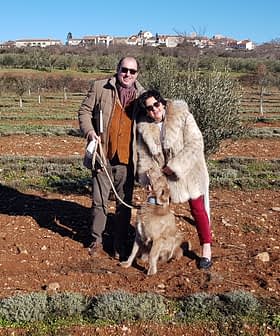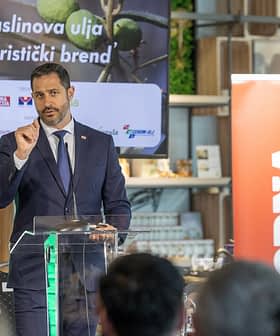As Harvest Begins, Croatian Producers Anticipate High Quality, If Not Quantity
While production figures are expected to decrease for the fourth consecutive year, quality is anticipated to be as high as ever.
 Olive trees in Istria
Olive trees in IstriaFor the fourth consecutive year, olive oil production in Croatia is expected to decrease. However, early reports from the producers who are already harvesting their olives indicate the quality of their oils will be quite good.
High temperatures in the olive-growing regions of the country earlier this year limited total olive yields and many in the sector are expecting an output of fewer than 3,000 tons.
The growing season in Istria this year was challenging mainly because of very high temperatures during the blooming period… we are expecting for sure 30 percent fewer olives than last year.
Tedi Chiavalon runs the 7,500-tree OPG Chiavalon facility with his family in Istria and says despite another year of low yields, producers in the region are excited about the quality of their crop.
“The growing season in Istria this year was challenging, mainly because of very high temperatures during the blooming period,” Chiavalon said. “Some cultivars… suffered a lot, so in our region, we are expecting at least 30 percent fewer olives than last year.”
“The harvesting period just started last week,” he added. “The olives look great. The weather is perfect.”
See Also:2019 Olive Harvest NewsChiavalon said there were no issues with the olive fruit fly like in past years, so producers in Istria “are expecting great results from this year’s harvest.”
In spite of stagnant production figures – production has been steadily declining since 2016 – many producers remain optimistic about the country’s olive oil sector.
Quality is widely seen to be on the rise. In May, 51 Croatian olive oils (out of 61 entries) took home an award at the 2019 NYIOOC World Olive Oil Competition.
Two months before, Chiavalon and other Istrian producers received more good news when the European Union announced extra virgin olive oil from Istria would receive Protected Designation of Origins (PDO) status.
The new designation recognizes the quality of oils from the Istrian peninsula as well as ensures their authenticity. The entire Istrian peninsula, which includes parts of Croatia and Slovenia, is included in the PDO.
After the hot blooming season (in which temperatures exceeded 86 degrees Fahrenheit), Chiavalon said there was plenty of rain and the weather proved beneficial to the blooms that survived the heat.
“We have really great natural and geographical predispositions for olive production,” Chiavalon said. “Istria is one of the northernmost areas of cultivation of olives in the world and our variety of olives in these conditions are giving incredible results.”
There are several variables that separate Istrian olive oil from other producers in the region. Due to its northern location, oil concentrates in olives later in the season – sometimes later than the other growing region in Croatia, Dalmatia – which results in robust, intense olive oils. Also, most Croatian olive oil groves are small, and so picking and processing olives by hand is common. That also means it is easier to get olives pressed within hours of being picked.
The native olives in the region, which have been planted for centuries, include Buža, Istrian Bjelica, Moražola and Rožinjola, whose oil varies in color when pressed but share a fresh, grassy and sometimes intense aroma.
Chiavalon said Croatian producers are constantly battling the elements – as evidenced by the four-year decline in yield – but producers are committed to pushing the industry forward.
“Every 30 to 40 years in the past, we had huge cold [spells] in winter so our region lost great parts of its production capacities over the centuries,” Chiavalon said. “From generation to generation, producers are replanting their orchards, and in the last 20 years many new areas are planted too, so in this way we keep the tradition of olive cultivation alive.”
“Climate change is also affecting our orchards as in all other parts of the world, so we’ll see what challenges we’ll have in the near future,” he added.
However, it is the focus on producing better, not more, olive oil that Chiavalon believes will help Croatian producers thrive in the coming years.
“We cannot allow ourselves to produce mediocrity,” Chiavalon said. “For this reason in all our phases of growing olives, production of extra virgin olive oil, storing, blending, bottling and labeling, the word ‘quality’ is something that stays at first place always.”









